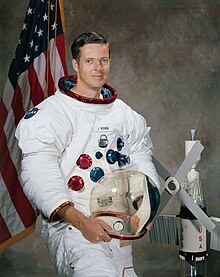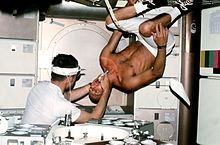| Joseph Kerwin | |
|---|---|
 | |
| Born | Joseph Peter Kerwin (1932-02-19) February 19, 1932 (age 92) Oak Park, Illinois, U.S. |
| Education | College of the Holy Cross (BA) Northwestern University (MD) |
| Awards | NASA Distinguished Service Medal (1973) |
| Space career | |
| NASA astronaut | |
| Rank | Captain, USN |
| Time in space | 28d 0h 50m |
| Selection | NASA Group 4 (1965) |
| Total EVAs | 1 |
| Total EVA time | 3h 23m |
| Missions | Skylab 2 |
| Mission insignia |  |
| Retirement | March 31, 1987 |
Joseph Peter Kerwin (born February 19, 1932) is an American physician and former NASA astronaut. He served as the science pilot for the Skylab 2 mission from May 25, 1973, to June 22, 1973. He was the first physician to be selected for astronaut training and the first doctor from the United States to enter space.
Kerwin was the one who uttered the words during Apollo 13: "Farewell, Aquarius, and we thank you." He was inducted into the United States Astronaut Hall of Fame in 1997.
Early life and education
Kerwin was born in Oak Park, Illinois, on February 19, 1932, as the seventh child of an Irish Catholic family. He attended Fenwick High School, a private school in Oak Park, graduating in 1949.
After graduating from high school, Kerwin enrolled at the College of the Holy Cross. He graduated in 1953 with a Bachelor of Arts degree, magna cum laude, in philosophy with a minor in pre-med, ranked eighth in a class of 380 students. During his junior year, Kerwin won a national rhyme contest involving Lucky Strike cigarettes. His senior thesis was titled, "Psychological Aspects of Competitive Swimming".
Kerwin received a Doctor of Medicine (M.D.) degree from the Feinberg School of Medicine of Northwestern University in 1957. He completed his internship at the District of Columbia General Hospital in Washington, D.C., and attended the United States Navy School of Aviation Medicine at Naval Air Station Pensacola before being designated a naval flight surgeon in December 1958.
Military career
Kerwin was a Captain in the Navy Medical Corps, commissioned in July 1958. He earned his flight surgeon's wings at Beeville, Texas, in 1962. He has logged 4,500 hours flying time.
NASA career
Main article: Skylab 2Kerwin was selected for NASA Astronaut Group 4 as a scientist-astronaut in June 1965. He was serving as a pilot and a flight surgeon for the Navy at the time of his selection. He was one of the capsule communicators (CAPCOMs) on Apollo 13 (in 1970).
Kerwin served as Science Pilot for the Skylab 2 (SL-2) mission which launched on May 25 and splashed down on June 22, 1973. With him for the initial activation and 28-day flight qualification operations of the Skylab Orbital Workshop were Charles "Pete" Conrad (spacecraft commander) and Paul J. Weitz (Pilot).
Kerwin was subsequently in charge of the on-orbit branch of the Astronaut Office, where he coordinated astronaut activity involving rendezvous, satellite deployment and retrieval, and other Space Shuttle payload operations. Kerwin was part of the NBC broadcasting team for coverage of the launch of STS-1.

From 1982–83, Kerwin served as NASA's senior science representative in Australia. In this capacity, he served as liaison between NASA's Office of Space Tracking and Data Systems and Australia's Commonwealth Scientific and Industrial Research Organisation. During this time, Kerwin was considered to fly on the mission that would become STS-41-C (then known as STS-13), but his assignment in Australia prevented his selection.
From 1984–1987, Kerwin served as Director of Space and Life Sciences at the Johnson Space Center. There, he was responsible for direction and coordination of medical support to operational crewed spacecraft programs, including health care and maintenance of the astronauts and their families; for direction of life services, supporting research and light experiment project; and for managing JSC earth sciences and scientific efforts in lunar and planetary research. In 1986, he issued a report on the deaths of the crew killed in the Challenger disaster to Associate Administrator for Space Flight, Richard H. Truly.
Post-NASA career

Kerwin retired from the Navy, left NASA, and joined Lockheed in 1987. At Lockheed, he managed the Extravehicular Systems Project, providing hardware for Space Station Freedom, from 1988 to 1990; with Paul Cottingham and Ted Christian invented the Simplified Aid for EVA Rescue (SAFER), first tested for use by space walking astronauts on the International Space Station (ISS) during Space Shuttle flight STS-64. He then served on the Assured Crew Return Vehicle team, and served as Study Manager on the Human Transportation Study, a NASA review of future space transportation architectures. In 1994–95 he led the Houston liaison group for Lockheed Martin's FGB contract, the procurement of the Russian "space tug" which has become the first element of the ISS. He served on the NASA Advisory Council from 1990 to 1993.
He joined Systems Research Laboratories (SRL) in June 1996, to serve as Program Manager of the SRL team which bid to win the Medical Support and Integration Contract at the Johnson Space Center. The incumbent, KRUG Life Sciences, was selected. Then, to his surprise, KRUG recruited him to replace its retiring president, T. Wayne Holt. He joined KRUG on April 1, 1997. On March 16, 1998, KRUG Life Sciences became the Life Sciences Special Business Unit of Wyle Laboratories of El Segundo, California.
In addition to his duties at Wyle, Kerwin serves on the Board of Directors of the National Space Biomedical Research Institute (NSBRI) as an industry representative. He retired from Wyle in the summer of 2004.
Personal life
Kerwin married Shirley Ann née Good of Danville, Pennsylvania in 1960. They have three daughters: Sharon (born September 14, 1963), Joanna (born January 5, 1966), and Kristina (born May 4, 1968); and six grandchildren. His hobbies are reading, golf and classical music. He resides in College Station, Texas with his family.
Organizations
He is a fellow of the Aerospace Medical Association, and a member of the Aircraft Owners and Pilots Association.
Awards and honors
The all-Navy crew was awarded the Navy Distinguished Service Medal in 1973 from the Secretary of the Navy. The three Skylab astronaut crews were awarded the 1973 Robert J. Collier Trophy "For proving beyond question the value of man in future explorations of space and the production of data of benefit to all the people on Earth." Gerald Carr accepted the 1975 Dr. Robert H. Goddard Memorial Trophy from President Ford, awarded to the Skylab astronauts. The Skylab crew was awarded AIAA's Haley Astronautics Award for 1974.
He was one of 24 Apollo astronauts who were inducted into the U.S. Astronaut Hall of Fame in 1997.
Books
Kerwin is co-author, along with fellow astronaut Owen K. Garriott and writer David Hitt, of Homesteading Space, a history of the Skylab program published in 2008.
In films
Kerwin is portrayed by Jack Hogan in the 1974 TV movie Houston, We've Got a Problem.
Joe Kerwin appears as himself in the 2018 documentary film Searching for Skylab.
See also
References
- "Skylab". The New York Times. May 13, 1973. ISSN 0362-4331. Retrieved October 16, 2023.
- ^ "First Medical Doctor in Space Joseph Peter Kerwin". The New York Times. May 26, 1973. ISSN 0362-4331. Retrieved October 13, 2023.
- Paul, Maria (November 11, 2009). "Northwestern Doctor Will Be First Orthopedic Surgeon in Space". Northwestern University News. Northwestern University. Retrieved October 16, 2023.
- Northwestern University Professor Selected for Astronaut Program (Northwestern University News)
- ^ Rusnak, Kevin M. (May 12, 2000). "Dr. Joseph P. Kerwin Oral History". NASA Johnson Space Center Oral History Project | Edited Oral History Transcript. NASA. Retrieved October 13, 2023.
- "Diverse Personalities Fit Together in Skylab". Chicago Tribune. Chicago, Illinois. May 14, 1973. p. 88 – via Newspapers.com.
- "Experts to Lecture at A Day With Northwestern". Northwestern News Center. Northwestern University. April 4, 2006. Retrieved October 16, 2023.
- "Orthopaedics Faculty Member to Join NASA's Newest Astronaut Class". Northwestern Medicine News Center. Feinberg School of Medicine. May 1, 2004. Retrieved October 16, 2023.
- "NASA's Scientist-Astronauts," David Shayler and Colin Burgess.
- ^ "Biographical Data | Joseph P. Kerwin" (PDF). NASA. Houston, Texas: Lyndon B. Johnson Space Center. February 2002. Retrieved April 3, 2021.
- "Six Young Scientists Become US Astronauts Today at Space Center". Lebanon Daily News. Lebanon, Pennsylvania. UPI. June 29, 1965. p. 17 – via Newspapers.com.
- "Vermont Scientist May Be On Early Mission to the Moon". The Burlington Free Press. Burlington, Vermont. Associated Press. June 28, 1965. p. 1 – via Newspapers.com.
- "Apollo by the Numbers".
- Burgess, Colin; David J. Shayler (2006). NASA's Scientist-Astronauts. p. 342. Bibcode:2006nasa.book.....S.
- Kerwin, Joseph P. (July 28, 1986). "Joseph P. Kerwin to Richard H. Truly". Archived from the original on January 3, 2013. Retrieved July 4, 2006.
- Recer, Paul (May 13, 1973). "Kerwin: Time Now for Homesteading". Democrat and Chronicle. Rochester, New York. Associated Press. p. 19 – via Newspapers.com.
- "Astronauts Honored". Florida Today. Cocoa, Florida. October 6, 1973. p. 5A – via Newspapers.com.
- "Collier 1970–1979 Recipients". National Aeronautics Association. Retrieved February 9, 2019.
- "Collier Trophy at Test Range". The Orlando Sentinel. Orlando, Florida. October 3, 1974. p. 21 – via Newspapers.com.
- "For Praises Astronauts, Space Program". Daily Press. Newport News. UPI. April 12, 1975. p. 23 – via Newspapers.com.
- "Astronaut Thinks Pioneering About to Begin in Space". Abilene Reporter-News. Abilene, Texas. Associated Press. October 31, 1974. p. 8-A – via Newspapers.com.
- Meyer, Marilyn (October 2, 1997). "Ceremony to Honor Astronauts". Florida Today. Cocoa, Florida. p. 2B – via Newspapers.com.
- "Living on the Final Frontier". Rocky Mount Telegram. Rocky Mount, North Carolina. December 14, 2008. p. 24 – via Newspapers.com.
- Searching for Skylab
External links
- Astronautix biography of Joseph P. Kerwin
- Kewrin at Encyclopedia of Science
- Joseph P. Kerwin at IMDb
- Official publisher website for Homesteading Space
| Skylab | |||||||
|---|---|---|---|---|---|---|---|
| Flights |   | ||||||
| Astronauts |
| ||||||
| Contingencies |
| ||||||
| People |
| ||||||
| Related | |||||||
| NASA Astronaut Group 4, "The Scientists", 1965 | |||||||
|---|---|---|---|---|---|---|---|
| NASA Astronaut Group 3 ← NASA Astronaut Group 4 → NASA Astronaut Group 5 | |||||||
| |||||||
- 1932 births
- Living people
- 1973 in spaceflight
- American people of Irish descent
- 21st-century American philosophers
- Catholics from Illinois
- 20th-century American philosophers
- United States Navy Medical Corps officers
- Physician astronauts
- Space medicine doctors
- United States Navy astronauts
- Apollo program astronauts
- Aviators from Illinois
- Physicians from Illinois
- Military personnel from Illinois
- United States Astronaut Hall of Fame inductees
- Writers from Chicago
- College of the Holy Cross alumni
- Feinberg School of Medicine alumni
- Recipients of the Navy Distinguished Service Medal
- Recipients of the NASA Distinguished Service Medal
- NASA people
- Lockheed Martin people
- 20th-century American physicians
- 20th-century American businesspeople
- Skylab program astronauts
- People from Oak Park, Illinois
- Spacewalkers